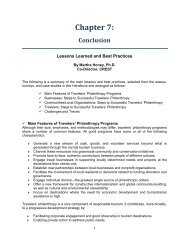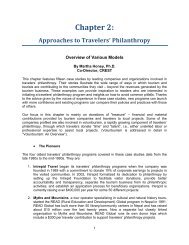Travelers' Philanthropy Handbook - Center for Responsible Travel
Travelers' Philanthropy Handbook - Center for Responsible Travel
Travelers' Philanthropy Handbook - Center for Responsible Travel
You also want an ePaper? Increase the reach of your titles
YUMPU automatically turns print PDFs into web optimized ePapers that Google loves.
project, the reporting may become overwhelming <strong>for</strong> small to medium sized projects. It is alwayssmart to look at the grant reporting requirements at the same time as you consider writing theproposal. Try to strike a balance between the size of the grant and the reporting requirements.Sometimes donor institutions may reduce reporting requirements due to the size of a grant – butthis is unusual.The case of private donors is quite different and you come across everything from quite heftydemands on reports to not wanting reports at all. In the latter case, it can be quite tempting toaccept money with no reporting requirements attached. However, there is self-interest inreporting <strong>for</strong> the simple reason that by keeping in close touch with the donor, you increase thelikelihood of renewed funding in the future.Basecamp sends out quarterly reports based on the same standard <strong>for</strong>mat <strong>for</strong> all projects. Thereports include donor newsletters as well as financial reports <strong>for</strong> annual audits. With a largenumber of projects running at the same time, standard reporting is of great help. So far, ourprivate donors and Corporate Social Responsibility (CSR) partners have accepted the standard<strong>for</strong>mat as a streamlined reporting system. This does not mean that other <strong>for</strong>ms ofcommunication are not needed. On the contrary, staying in touch with donors with the support ofweb and social media is extremely useful in between the quarterly reports -- but this is differentand does not replace the <strong>for</strong>mal reporting described above.5. Difference in PrioritiesDifference or mismatch in the priorities between the project and the donor can have manyaspects. One has to do with “need driven” versus “donor driven” funding, which we talked aboutearlier. This aspect is mostly in play be<strong>for</strong>e the onset of the project and there<strong>for</strong>e easier tomanage since the option to say “no” to donorsupport is still there. Another aspect comesinto play when the project is operational andthe donor seeks to alter the terms ofengagement by putting <strong>for</strong>ward new demands<strong>for</strong> the project. The demands can alsooriginate from a project partner, or acommunity member who seeks to influencethe project and the donor, and by doing sosuddenly make the project unstable andcomplex to manage.This can happen, <strong>for</strong> instance, when the CEOor the project manager of a fundingorganization is replaced and the new personHIV/AIDS Awareness, Kenya. Credit: Basecamp Foundationthat wants to put his or her profile on theorganization -- including the CSR profile. Such situations can easily jeopardize the entirepurpose of the project by leading to changes in activities, overall goals, and even funding can beat risk of being withdrawn from the project.Basecamp Foundation has experienced a few such cases. The lesson learnt is that wheneverpossible; try to institutionalize the partnership be<strong>for</strong>e the onset of the project. One way of doingthis is to develop clear Terms of Reference <strong>for</strong> the project and/or Memorandum ofUnderstanding between the partners, including the role and responsibilities of the donor. Toinstitutionalize each and every partnership is not always practical, especially <strong>for</strong> small projects128















